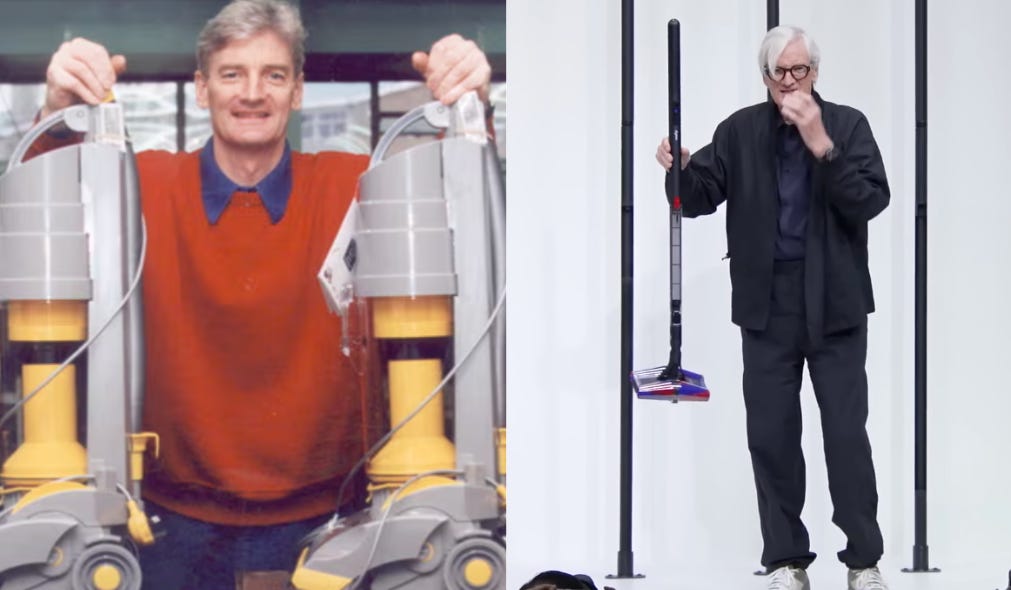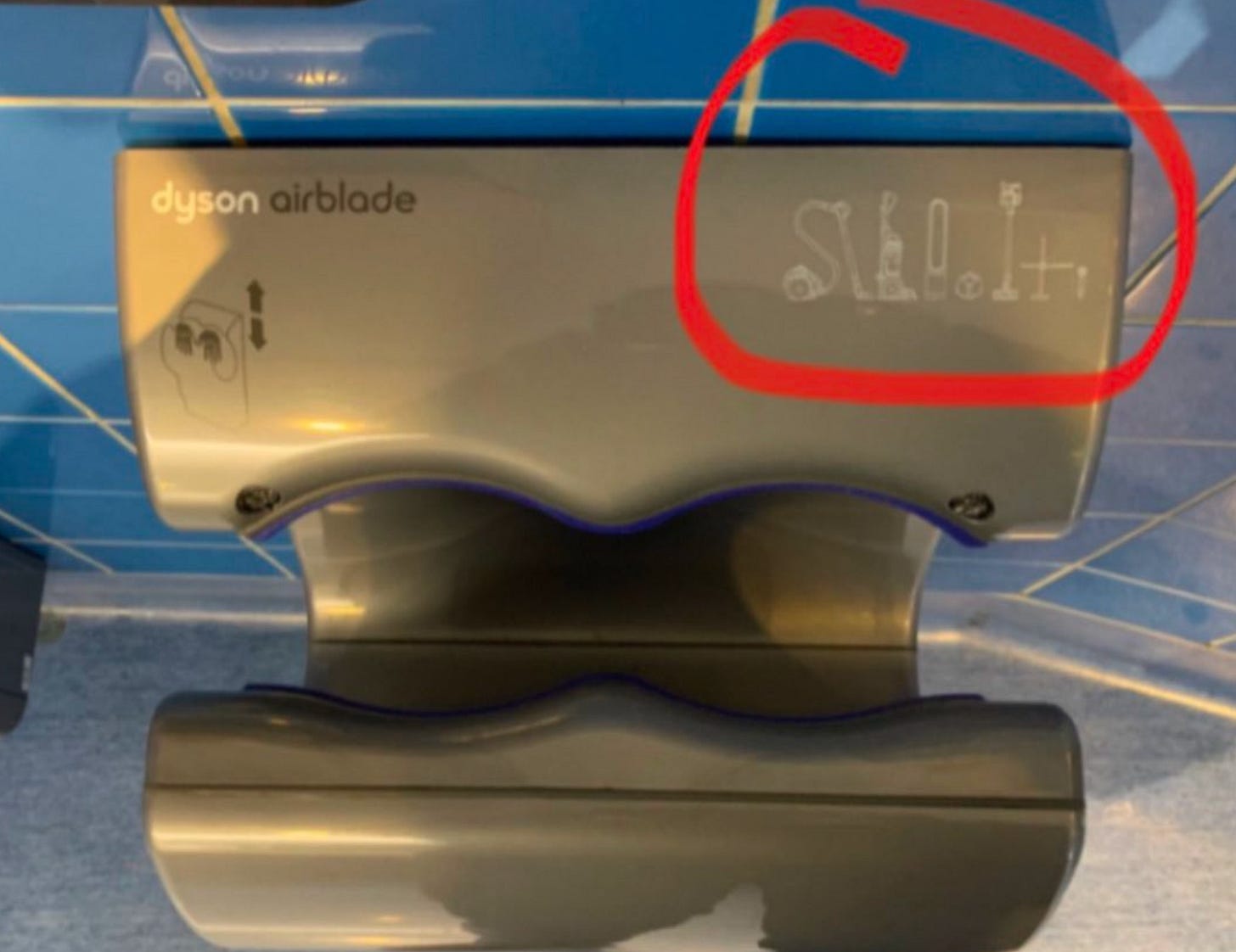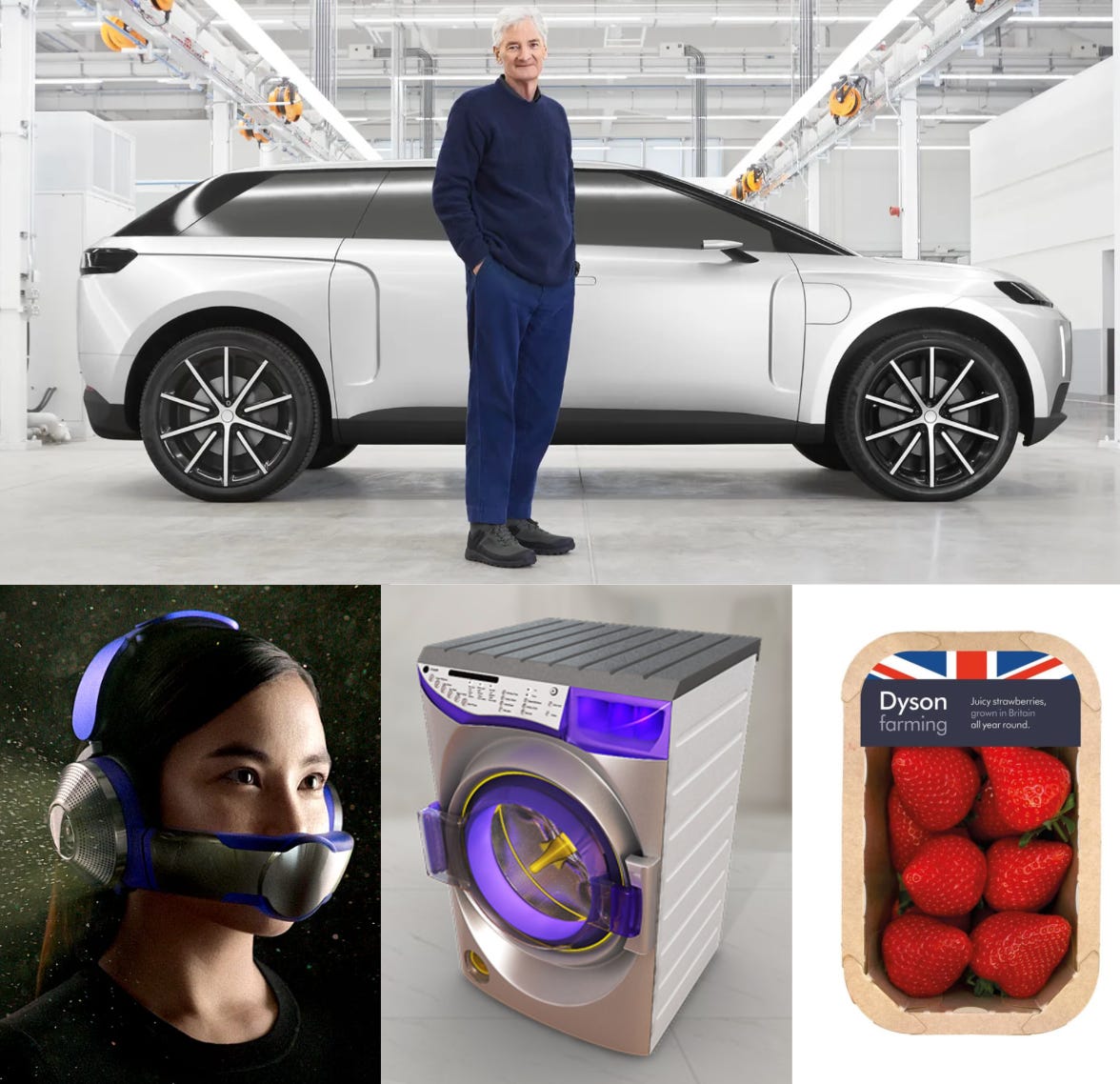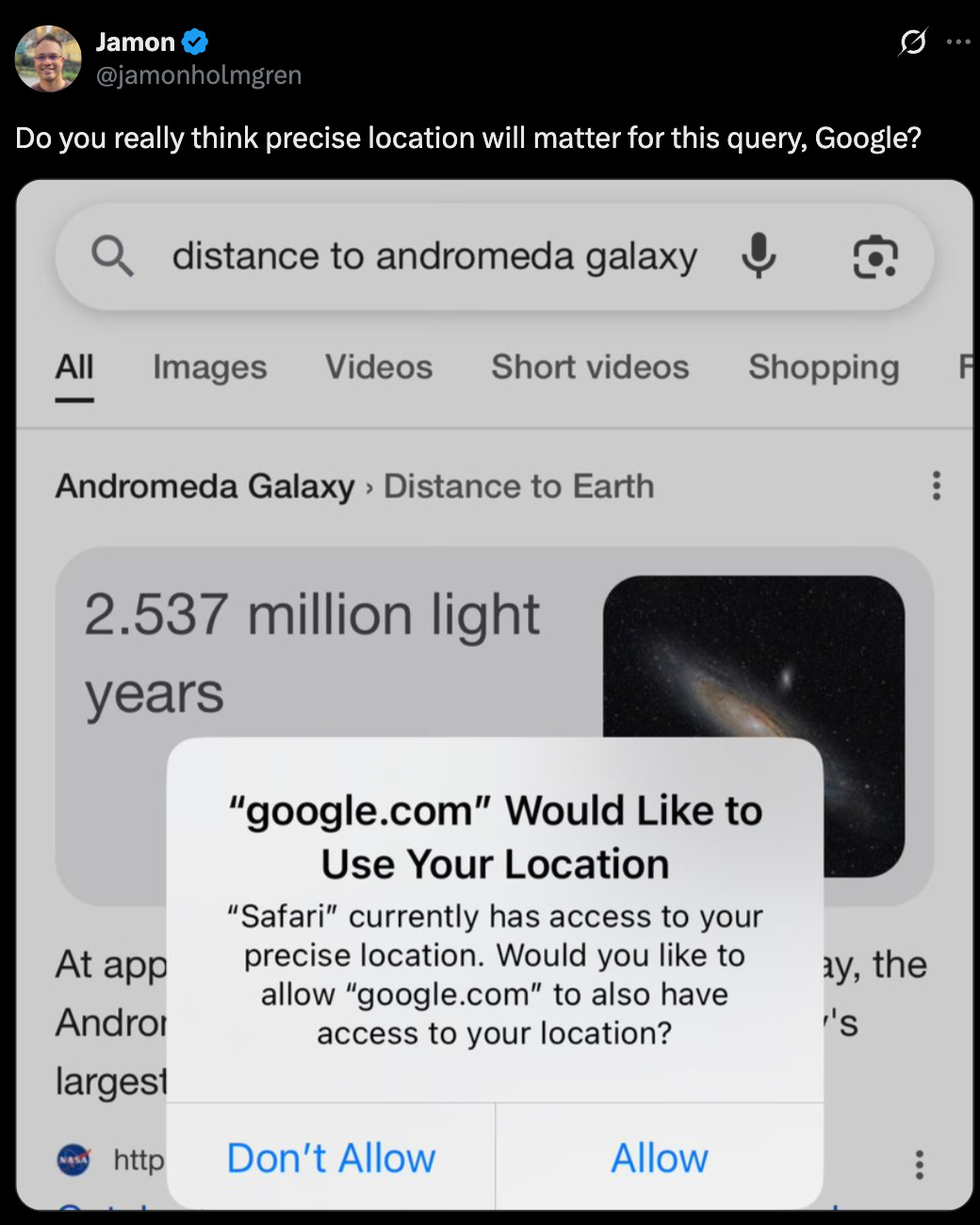The Dyson Creep-Up
James Dyson is 78 and just launched "the world's thinnest vacuum" in the most dialled-in 8-minute pitch ever. It will look great next to your Dyson fan, air purifier, hair dryer and other vacuum.
Thanks for subscribing to SatPost.
Today is about James Dyson’s “thinnest vacuum ever” and what we can learn from the 78-year entrepreneurial legend.
Also this week:
AI and The Rise of Liquid Content
The Best of Google’s Veo 3 video model
…and them fire posts (including SF parties)
I had a conversation with a buddy on random stuff our wives buy.
Just a couple throwaway lines on iMessage while I was pretending to do work.
This banter led to the coining of the term “The Dyson Creep-Up”, a phenomenon when your home starts randomly gathering more and more Dyson products. We were so pleased with ourselves that we spiked our dopamine levels by tapping that laughing crying emoji on the messages. It was pathetic.
Anyway, close your eyes and you’ll know exactly what I mean: it all starts with the Dyson vacuum. Probably a V15 Detect. The slim one? Maybe the V7 Advanced Cordless? If you got more storage room, maybe you’ll teabag yourself with the Big Ball Turbinehead™ (actual product name).
Then, one day your wife brings home a Dyson Fan and Heater for the living room. That is quickly followed by the Dyson Air Purifier. Then another Dyson Fan for the bedroom. The second Dyson fan is when you start asking, “Yo, dafook is this? Ain’t no way Dyson made a fan and even if they did, we ain’t paying a premium on a fan because Dyson made it.” The missus pulls out the Uno Reverse Card and says, “Are you the one cleaning the house? That's what I thought. I don’t want to hear any Dyson-related complaints.”
Touché.
Fast forward a couple months, you’re getting ready for date night and she whips out what looks like a Star Trek gun with the Dyson logo on it…that’s the Supersonic Hair Dryer. Finally (mercifully), she tops it all off with the rose-colored Dyson Airstrait™ hair straightener.
What began with “hey, let’s check out the vacuum aisle of Best Buy” that turns into “how do I have $5k of Dyson product in my house?”
We are talking Apple-levels of hardware spend that just creeps up on you.
That my friends is The Dyson Creep Up™.
And the creeping will continue until morale improves.
Why? Dyson founder James Dyson is still working hard at 78 years old and recently dropped a launch video for the “world's slimmest vacuum” (correction: Sir James Dyson).
The 8-minute video is the tightest product pitch you will ever see in your life.
Meet The Dyson PencilVac Fluffycones…say it with me, “The Dyson PencilVac Fluffycones”:
It is (allegedly) the world’s thinnest cordless vacuum with a handle (38mm, 1.8kg) comparable to a Dyson hair dryer handle (which I know all about because see the 7th line of this essay).
It has special cones (Fluffycones), so that hair doesn’t get stuck in the device (unreal lol).
A new flexible design so that the cleaner head goes right against walls, under tables and up in cupboards.
A 360-degree green illumination laser so you can see all dirt.
A powerful new motor — the diameter of a coin — that is entirely in the handle of the vacuum and spins at 140,000rpm (for reference, a Formula 1 car goes 15,000rpm and jet engine goes 16,000rpm)...and swappable batteries.
The probability of me seeing this product on the credit card bill when it’s available next year is somewhere between 98.7% and 99.9%. There will be PencilVac-ing and Fluffycone-ing in the Phan household!
I literally have no idea if we actually need it. But, yeah, I’ve already mentally spent the money because Dyson just won’t stop grinding. It’s crazy. Dude is wrapping up his 8th decade of life and is worth ~$20B from his 100% ownership of the Dyson business, which does $8B a year in sales and employs 14,000 people. Rather than retire, he probably lost over a thousands nights of sleep trying to figure out how to get hair unstuck from the cleaner head and here we are.
Born in 1947 — 8 years before Steve Jobs — Dyson started working on a bagless vacuum in the mid-1970s. Famously, he spent 15 years and made 5,127 design prototypes before releasing his first commercial product in 1993 (DC01 aka first version of the patented Dual Cyclone technology vacuum). Yes, that works out to 342 different prototypes a year because Dyson would adjust a filter by a few inches and he would consider that a different prototype. Some might quibble with the math but seems legit to me.
Either way, this man has been thinking non-stop about vacuum tech for half a century.
It is official. No one in the world is more obsessed with anything than James Dyson is obsessed with miniaturizing motors to create powerful airflow inside a bagless vacuum that cleans dirt and dust from various surfaces around the home (ok, maybe Jiro with sushi or Todd Graves with chicken fingers).
The dedication is part inspiring and part high comedy.
Dyson is working at the level of hair strands and combines that engineering with a name, “Fluffycones™”, which is somehow even more erotic than “Big Ball Turbinehead™”.
He’s also out here in Tokyo physically demo-ing the PencilVac’s nimbleness. Think about this. He’s in his late-70s and wheeling around dirt obstacles courses with the world’s thinnest vacuum. They even dimmed the lights to flex the illumination!!!
The entire demo is Peak Steve Jobs. Dyson masterfully dissect the problem set (stuck hair, heavy vacuum) and offers an elegant solution. Other than the name itself, there aren’t a ton of buzzwords. It’s a quick and understandable pitch.
Since the mid-1990s, Dyson is right up there with Steve Jobs and Jony Ive for making slick consumer hardware that's seen as premium in the respective categories (correction: Sir Jony Ive, who actually replaced Dyson as the Chancellor in London’s Royal College of Art in 2017).
Other than thinking “wow, this Jobsian”, three other things came to mind while I was watching the PencilVac Fluffycones demo. First, Dyson and Apple products have both been accused of planned obsolescence but that’s a 10,000 word rant that I’ll save for another time. Second, I still can’t believe they called it Fluffycones. Third, the existence of this product is the perfect encapsulation of the Dyson life philosophy.
What do I mean? Back in 2021, Dyson published a book called “Invention: A Life of Learning Through Failure”. I haven’t finished it yet but did listen to an interview Dyson did on The Tim Ferris Podcast, which has a ton of great nuggets on his approach:
Obsession: While Dyson started messing around with different vacuum models in his early-30s, he says his frustration with vacuums dates back to his childhood. The old machines didn’t clean and the mess left an odour. Never forget the the connection between smell and memory. Odors go directly to the olfactory bulb, which is next to areas in the brain that process emotions (amygdala, hippocampus), and that’s why smells are more powerful triggers for memories than other senses. So, he's been pickled by this problem for 70+ years. I re-iterate, no one in the world is more obsessed about anything than Dyson is about removing dirt and dust from various home surface:
Dyson: “Well, when I was young, the only machine we had at home, we didn’t really have any money when I grew up, was a vacuum cleaner. It was a little, old-fashioned, upright vacuum container with a huge pillowcase on the back, this sort of thing. I just remember, I was made to clean the house with it by my mother. And I just remember the horrible smell of stale dog and stale dust, it not picking things up, and then having to go outside and shake the bag out and then restarting the machine and it still not working very well.
So I just remembered that from my childhood. And then when I was starting a family and had a wife and so on, I bought a second-hand one of these original type of vacuum cleaners with the pillowcase on the back hanging off of it. Same experience. So I thought, 'Well, there must be a more modern version.' So we went to the shops, me and my wife, and we bought what was allegedly the most powerful vacuum cleaner in the world. And it was a canister model that sits on the ground.”
Even Boring Categories Can Be Improved: When Dyson cracked the code to create a bagless vacuum, he tried to license the technology to existing manufacturers. Basically, all of them told him to kick rocks because vacuums weren’t a sexy category and the device was just viewed as a commodity not worth improving for the likes of Hoover and Electrolux:
Dyson: “I really noticed that [existing manufacturers] weren’t interested in changing their technology. They wanted to stick with what they had. It’s what I call a commodity product. It’s not a very exciting product. They’re not skis or surfboards or anything interesting. Vacuum cleaners were a commodity product in which no one had any interest. So I could sort of see why they weren’t bothering because consumers weren’t really bothering. It’s that thing with a bag that sucks. But I saw it differently. You use it every day. It makes a noise. It’s supposed to do an efficient job of getting rid of dust, which is nasty stuff and keeping it inside the machine and getting up dog hairs and all the awful things. If it doesn’t do that properly, your life is not as pleasant. I saw it as a very important thing. I mean, it’s a mundane product. It’s an apparently boring product, but I thought we should make it interesting. It’s an important product.”
A Supportive Partner: Dyson married Deirdre Hindmarsh in 1968. They have been together for nearly 60 years and have three kids. She stuck with him and trusted him while he fumbled around for over a decade. They had bank issues and had to mortgage their home to make it happen.
Dyson: “My wife was wonderful. There were no difficult conversations. She believed in it. She’s an artist and was wonderfully supportive, but she understands the need for a project and to create something. The need to create, the need to have a project. So, she never once complained although we were incredibly short of money. We had to grow our own vegetables and she made our clothes, and she was hardworking and wonderfully supportive. There were never any difficult conversations. Even when we went to London Bank with a lawyer to sign endless guarantee forms, putting the house on the line, every penny we had on the line. I’m very lucky.”
100% Ownership: Dyson actually started the business with a partner named Jeremy Fry. They each put in ~$50k. Fry from his own funds while Dyson borrowed $50k from the bank. The split was 49% Fry and 51% Dyson. Eventually, Fry didn’t want to go along for the ride and Dyson bought out his share for…~$50k. Ouch. Going solo worked for Dyson, though.
Dyson: “[Fry and I had] a very friendly parting. I quite understood it. The vacuum cleaner wasn’t his life. It was my life, not his life. So I bought him out for 45,000 pounds, and I was on my own. In many ways actually, he was a huge help. He was my mentor, a great friend, and a wonderful designer and engineer. So I felt a bit lonely going off without him. But on the other hand, it actually made me feel better being completely on my own. It suited me…I didn’t think it would make me uncomfortable, but it did, and the reason it made me uncomfortable is that — if someone else has put money in and if someone else has shares — you have to listen to them. And I felt I had to listen to them, so you’re not actually running the company, you’re sharing the running of the company, and a lot of decisions will be decisions that they want quite rightly, because they’ve put a lot of money into it.”
Anyone Can (And Should) Learn Engineering: Dyson is such a believer in hardware engineering that he launched his own university. In 2017, he opened the Dyson Institute of Engineering and Technology in Wiltshire, England. Students at the school work at Dyson three days a week, receive a salary, and have their tuition fees paid during their four-year course. He prefers to hire newly grads that aren’t saddled with older ways of thinking.
Dyson: “Engineers and scientists can solve…problems, but the pity is that that schoolchildren and even people at university don’t realize that, people would rather talk about it than do something about it, and I think that’s a great shame. I do think that a lot of people think engineering is hard and difficult, that science is hard and difficult and of course, perhaps it is, but it’s also very creative and people don’t see that either.
If I could somehow show through the book that a stupid person like me — a person who is not academic and is not brilliant at all [but] through really caring about products, caring about technology, caring about engineering — can produce products that save energy that use fewer resources and that work better...The theme of [my book] is really that you don’t have to be an expert and in fact, experts are often unhelpful. You have to have enthusiasm, curiosity, a thirst for knowledge, and determination. And those are the things that will solve all the world’s problems.”
At the end of their chat, Ferriss asked Dyson what phrase he’d put on a billboard for the world to see. He gave two: 1) “There’s nothing wrong in always being dissatisfied; always look for improvement.”; and 2) “Drop your fear of failure; don’t be afraid of failure.”
The latter point is particularly salient as Dyson recently spent over $500m trying to make a luxury EV but ultimately tapped out. One reason he moved Dyson’s HQ from England to Singapore was to work with the Asia supply chain on the product even though it never panned out (another reason was also tax related). That was definitely his most expensive L.
The most embarrassing L was either the Dyson washer and dryer or the Dyson filter facemask. A controversial L is the Dyson Air Blade in public bathrooms, which is both Dyson’s first major non-consumer device and also something that probably blows germs everywhere and doesn’t really dry your hands. Although, that might be a W for Dyson because it ingeniously uses that surface area to advertise its own products (I’m so committed to the journalistic endeavour that I awkwardly took this photo a few years ago and knew it would come in handy as a primary source).
Let me balance the ledger by flagging a random W: the Dyson strawberry farm.
Obviously, your mileage will vary on the lessons from Dyson’s life.
I’m mostly interested in typing his quotes out because all these elements — a lifelong obsession on a "commodity" product, 100% ownership, a supportive partner, the love of engineering and fearlessness — is literally the only way someone could release something called the Dyson PencilVac Fluffycones which will retail for $500+ and probably fly off the shelves.
Even if it doesn't sell well, you know Dyson will extract some value from the experience based on the subtitle of his book (“learning through failure”). So, what are potential lessons we could learn if this product flops?
When I posted the PencilVac Fluffyones launch vid on X, it (unsurprisingly) went pretty nuclear viral and user Tsung Xu brought up an interesting point:
Yes this design is pretty but misses the mark. [Dyson] underinvested in RoboVacuums and is currently getting absolutely crushed. One in two vacuums sold globally is now a robot vacuum and no one under 40 wants to manually clean floors any more
When people pointed out that Dyson sells a few models of Robovacuums, Xu noted that the brand has minimal share compared to iRobot, Shark and countless random Chinese models.
When others brought up that RoboVacuums actually aren’t great at sucking and, thus, the ideal combo is to own a RoboVacuum and a handheld, Xu shot back that “being the premium choice in a shrinking market vs. winning in the fastest growing robot category which is already half the market” is “not a recipe for winning.”
To definitively settle the dispute, I asked my wife: her take is that RoboVacuums are for daily maintenance while deep cleans still require a handheld vacuum. She was actually a little bearish on the PencilVac Fluffycones because its thin design means it holds less dirt and she’d have to do multiple rounds of clean-up and emptying. But she was interested in the product as a cleaner for non-floor surfaces.
On her point about the volume of dirt to be collected, I actually think that as more homes go to a combo of RoboVacuum and handheld, the thinner PencilVac design fits the storage needs quite well (disclaimer: this opinion is worthless since I do very little vacuuming).
During the conversation with my wife, I asked her about the The Dyson Creep-Up™.
Was Dyson actually a better product than the cheaper alternatives? Is this absurd 51-second video of Dyson’s product testing factory — aka where it “relentlessly tests” device — just hype?
My wife said that the original Dyson vacuum purchase was based on both performance and aesthetics. The hype was legit. Finally, she had a vacuum that worked very well and was nice-looking enough that it didn’t have to be hidden in the storage room (and thus easier to use because it’s right there when you need it). A notable quibble is that some Dyson models have had battery-life issues. But Dyson’s customer service has been decent at responding to replace parts.
The Dyson fan and air purifier used the same air flow innovations and delivered on performance too (Dyson was originally inspired after seeing how sawmills use cyclone power to get rid of dust, which is one of my favourite “cross-industry innovations” ever).
But my wife acknowledged that these non-vacuum Dyson devices were also appealing because they “completed the set”. That same rationale applied for why she bought the Dyson hair dryer and straightener.
In the end, these two conversations — first with my friend and then with my wife — really hammered home a popular truism in retail: women make ~80% of the consumer buying decisions for a family.
Thankfully for our budget, Dyson discontinued the washer and dryer (although, any Creep-Up into a Dyson EV would have been entirely on me).
This issue is brought to you by Liona AI
Launch a GPT Wrapper in Minutes
As many of you SatPost readers may know, I’ve been building a research app for the past few years (Bearly AI). The app required a flexible backend to manage all of the LLM APIs.
Inspired by James Dyson’s ability to re-purpose his air flow innovations from a vacuum into a frickin' hair dryer…
...we turned the backend platform into a product for users and teams to directly (and quickly) connect to OpenAI, Anthropic, Grok, Gemini, Llama, Cursor and more while you maintain complete control over security, billing, and usage limits.
AI and the Rise of Liquid Content
Marshall McLuhan famously said that “the medium is the message”.
You can spend a lifetime unpacking the idea but the gist is that the form that a message is delivered in is as important as the message itself.
Here’s an example from my life: reading a book on my iPhone is a much more distracting and lesser-focussed experience — because I’m a cocaine rat swiping over to X after completing 1% of a book on Kindle — than reading a physical copy of the book. Also, listening to the audiobook of the book is less meditative and less sticky than actually reading the words and forming the words in my head as I read.
The medium that I take in the information is clearly as important as the information itself.
So what does that have to do with AI? This recent wave of generative AI products — voice, text, audio, video — is creating a situation where the content of any medium can quickly be quickly mutated into any other medium.
In a solid essay, Ryan Khurana calls this phenomenon “liquid content”:
Welcome to the age of Liquid Content—where information flows seamlessly between mediums, transforming its shape while preserving its essence. What was once fixed—text, audio, video—now exists in a state of perpetual potential, ready to materialize in whatever form serves the moment.
Since every person has a favourite way of consuming content, this will expand the audience for all types of different works.
To show how audiences change through different mediums, Khurana uses the example of Spotify adding audiobooks to its music streaming app…and shows how the model is different than consuming an audiobook on Audible:
Contrast Amazon’s focus on content (in this case books) across mediums with Spotify’s focus on medium across content. Spotify’s addition of audiobooks to a music streaming app might seem like just adding content, but it’s actually a change in medium context with big effects on consumption. Spotify’s medium is different: it’s a general audio platform for music and podcasts, now offering audiobooks in a time-based model. This shift in medium and pricing model has started to change user behavior in notable ways.
According to Spotify’s own observations, their audiobooks are reaching a different audience and surfacing different titles than Audible. Spotify CEO Daniel Ek noted that many listeners on Spotify explore lesser-known works and younger or emerging authors – content they might skip on Audible – precisely because the medium’s structure (listening hours up to a cap across the library, integrated in a familiar app) encourages sampling and serendipity. On Audible, the credit system nudges users toward “safe bets” (bestsellers, famous authors) since you essentially purchase one audiobook at a time. But on Spotify, the audiobook lives side by side with songs and podcasts, and you can dip in without an extra fee per book, lowering the barrier to trying niche topics. The medium (an audio app that people use casually throughout the day) becomes the message: it frames audiobooks less as a dedicated reading experience and more as another form of on-demand audio entertainment.
The difference highlights McLuhan’s point: the platform is not neutral. Put audiobooks into the music streaming medium and you get different patterns of use than in the audiobook-specific medium. Listeners on Spotify consume books in more fragmented, exploratory ways – perhaps listening in shorter bursts between songs – whereas Audible users might carve out long blocks of focused listening. The same stories take on a new life when the medium changes. How we consume is shaped by where we consume. Context reshapes content.
You know who will be very good at facilitating all of this content shapeshifting? Google.
It owns the entire AI stack from cloud infrastructure to model to consumer distribution. More so than any of their competitors, they have all the pieces dialled in but have to do a much much better job of packaging it…which is currently god awful as my Bearly AI co-founder Parham has pointed out:
The LLMs are named Gemini 2.5, Gemini 2.5 Pro, Gemini 2.0 Flash-Lite.
Then they have AI Overview (search), AI Mode (chat), NotebookLM (podcast), Veo (video) DeepResearch (research), Imagen (image), Whisk (remix) and VertexAI (enterprise).
All different apps. Got it?
Anyway, Google CEO Sundar Pichai was on the Decoder podcast after Google’s I/O conference and they clearly know about the “liquid content” opportunity.
He brought up the point that since Google’s models are “natively multimodal”, then AI “will make it zero friction to move from one format to another”.
I think things are becoming more dynamic, cross-format. I think another thing people are underestimating with AI is, AI will make it zero friction to move from one format to another, right? Because our models are natively multimodal.
We kind of tease people's imagination with audio overviews in NotebookeLM. The fact you can throw a bunch of documents at it, and you have a podcast and you can join and learn from it. You produce content by format…and machines can help translate. It’s almost like different languages and they can go seamlessly between them. I think [this is] one of the incredible opportunities to be unlocked [by AI].
Man, I can’t wait for the entire Succession series to turn into a podcast conversation or watch Robert Caro’s Lyndon B. Johnson’s books as a bunch of hip-hop themed TikTok clips.
The Best of Google’s Veo 3 Video Model
Speaking of AI content, Google’s new Veo 3 video model can only be described as "stupid good".
For about $3 of credits, users can generate 8-10 seconds of high-fidelity video along with audio. These videos are all made with a text prompt. The demand is so high that Google is gating how many videos can be made. The actual making of longer-form content — that string together multiple clips — also requires a lot of experimentation. You may make 100 clips and only get 10 usable ones.
I bring all this up because an extremely viral video came showing “an emotional support kangaroo being denied entry on a flight”. The good people at Know Your Meme have a rundown of the story and the main point is that I’m an absolute sucker and believed it was real for a solid 18 hours. So did A LOT of the rest of the internet.
Should I have known better? Probably. But I’ve seen enough “people arguing at the airport gate” viral videos to let my guard down. Also, my distracted brain didn’t pick up on some obvious cues like the two people speaking gibberish (although, making them argue in a non-English language is obviously smart), an “infinity” sign at the gate and … THE KANGAROO IS HOLDING THE F**KNG TICKETS!!
I am an idiot for falling for this and weep because if me — Mr. Spend 12 Hours a Day On X Editing Videos and Images For Cheap Laughs — is falling for this gag, then normies have no chance.
This thing went insanely viral and was probably the Pope Coat moment for AI video.
Both the Pope Coat and Emotional Support Kangaroo played with ingredients that can easily fool people. Pope swag always goes hard so maybe the Vatican did do a collab with Balenciaga (Ferrari once gifted the Pope a vehicle). Meanwhile, kangaroos hop around and have that pouch and, I dunno, seem pretty cute and crazy to me…and both times I visited Sydney I saw some wild stuff....so an emotional support kangaroo seemed within the realm of possibility.
This newsletter has talked about why the rise of generative AI content should make us default skeptical of everything we see online to an even greater extend than we've ever done before. Well, that’s definitely my new rule. From now on, if I see any text, video, audio or an image of an animal native to Australia, I will assume it’s fake.
***
Quick pivot. I don’t even know if this stupid kangaroo that tricked me was made with Veo 3 but I do know that Veo 3 can easily crank out such insane videos because here are some recent hits:
The Veo 3-to-OnlyFans pipeline is going to be crazy
The Dor Brothers made an awesome compilation of “what would influencers do if the world was ending” and called it (gloriously) “Influenders”
Truly wild short film about microplastics.
Very ceative and meta video by Hashem Al-Ghaili titled “Afterlife: The unseen lives of AI actors between prompts”
Veo 3 whisperer PJ Accetturo dropped a hilarious fake pharma ad with this must-click title “I used to shoot $500k pharmaceutical commercials. I made this for $500 in Veo 3 credits in less than a day. What’s the argument for spending $500K now?”
Speaking of PJ Accetturo, he went on Greg Isenberg’s podcast and explained his entire process in a 46-minute interview (“How I use Google Veo3 to create viral videos"). It’s well worth a watch and they go through some interesting monetization opportunities including starting a digital ad agency and building an entirely new narrative world with Veo 3 clips and then selling brand ads through the content.
You know what would slap? The Office but with talking kangaroos. You're welcome.
Links and Memes
Meta partners with Anduril on a military AR headset…capping off a Jobsian Silicon Valley comeback story for Palmer Luckey (or for all you NBA stans, kinda like Lebron going back to Cleveland).
Some background: Anduril founder Palmer Luckey previously founded VR headset startup Oculus and sold it to Facebook in 2014 for $2B and a promise from Zuck to spend $10B on development. Two years later, Luckey was pushed out of Facebook because he spent $9k on a single anti-Hillary Clinton billboard. This was still in the heat of the heatiest cancel culture and when 99.99% of Silicon Valley political donations and public support was for Democrats. Translation: Luckey was basically fired for being a Republican.
Luckey went on to found defense startup Anduril, which builds AI platforms and drones for the defense industry. The startup is now in funding talks to value it at $28B and recently picked up a $22B AR/VR headset project for the US Army that Microsoft couldn’t complete.
Over that span, Meta spent $60B+ on Zuck's headset and metaverse ambitions. While they’ve found success with Meta Raybans, those are still a “nice to have” not a “must have”.
If Zuck wants to commercialize the tech, obviously a Defense Department contract would be **Larry David voice** pretty pretty nice. Well, Meta isn’t a defense contractor just yet. Anduril will have the contract with the government but Meta — including all of that original IP that Luckey pioneered — will provide tech and research to help build a next-gen military AR headset dubbed “Eagle Eye”.
Apart from the business opportunity, Meta is facing a number of government anti-trust trials and the move certainly could be in part play nice with the administration (which Zuck has been doing a lot of since November).
In a 2-hour interview with Ashlee Vance, Luckey lays out how the deal came together and why he was OK to bury the hatchet with Facebook. It’s a solid listen.
***
Some other baller links for your weekend consumption:
Scamming Substack? Will Storr makes a compelling case that some Substackers are using AI to generate sentimental cliche slop writing and somehow fooling people and monetizing it.
Dark Leisure Theory of AI: Are we not seeing AI in the productivity stats because people are hiding the usage from their bosses…thus allowing them a lot more time to dick around on social media? SEEMS VERY PLAUSIBLE.
How to Live on $432 a Month in America: A.M. Hickman breaks down how he moved to upstate New York and lives on $432 a month all expenses paid. He says people complaining about the rat race are missing the opportunity to own a <$50k home with nature everywhere if they just moved to a rural area. The numbers pencil out but the sacrifices seem not worth taking to me (no amenities, family and friends far away, nearest airport is 2 hours away in Montreal and you have to cross a border both ways to get anywhere etc). Interesting read, though.
An automated haircut robot: Yes, you read that right…engineer Shane Wighton, built a machine programmed with “a variety of haircut styles”…wish I had this growing up instead of the pho bowl my mom used to clip my hair.
…and them fire posts:














Hey Trung. The Sydney Sweeney tweet links to the quoter's profile instead of the actual tweet
This was such an entertaining read 😂👏 “The Dyson Creep Up™” perfectly captures the slow but inevitable takeover of Dyson products at home. Loved how you wove in the banter, the Apple-level spending analogy, and then capped it off with the hilariously named PencilVac Fluffycones (seriously sounds like something straight out of Star Trek).
What really works here is the mix of humor and sharp observation — it’s so relatable because we’ve all had that moment of realizing a “just one purchase” brand somehow multiplied in our homes. The way you broke down Dyson’s ability to make the most ordinary household tools feel like luxury tech was spot-on.
This essay is witty, self-aware, and super fun to read — easily one of the best takes on how branding creeps up on us. More of this, please! 🙌